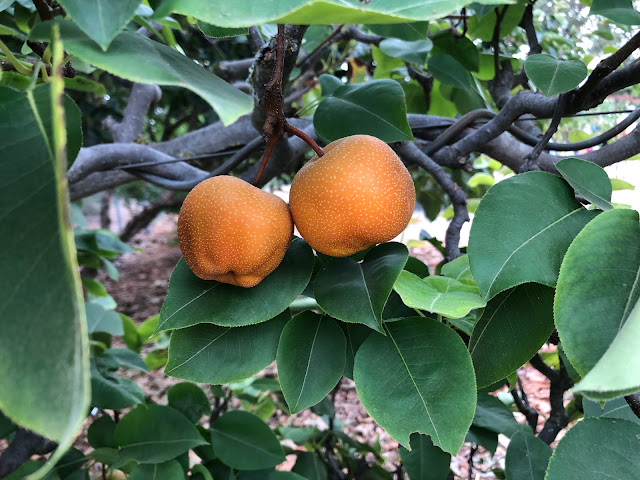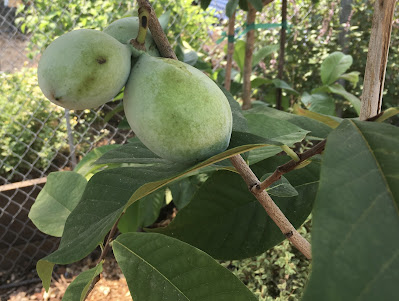
Harvest Day spotlights wide range of varieties in demonstration orchard

|
|
Asian pears grow on an espaliered tree at the Fair Oaks Horticulture Center. (Photos: Kathy Morrison)
|
Ever see a pawpaw? What about an atemoya or a pluerry? Those are just a taste of the exotic fruits that grow in the Fair Oaks Horticulture Center’s demonstration orchard.
Designed to be easy-care and easy-picking, the orchard is pruned for compact spaces – such as a typical Sacramento backyard. But small spaces can produce big harvests.
See for yourself Saturday, Aug. 6, during Harvest Day, the Sacramento region’s celebration of gardening know-how.
Hosted by the UC Cooperative Extension Master Gardeners of Sacramento County, this free event is annually Sacramento’s biggest free garden party. But due to pandemic restrictions, this will be the first in-person Harvest Day since 2019. Hours will be 8 a.m. to 2 p.m. Admission and parking are free.
Sacramento County master gardener Quentyn Young, a longtime professional nurseryman, oversees the 60-tree orchard. Young and other volunteers will be on hand Saturday to answer all sorts of questions. What’s the best tasting peach? How can you get more fruit in a small tree? Can you grow tropical fruit in Sacramento?
At the Fair Oaks Horticulture Center, the master gardeners experiment with techniques of care as well as testing varieties for hardiness, disease resistance and flavor.
Says Young, “We grow a lot of fruit: Peaches, nectarines, plums, pluots, pluerries, cherries, apples, pears, Asian pears, avocado, atemoya, pawpaw, guavas, figs, pomegranates, persimmons and all kinds of citrus.
“We’re having a really good fruit year, especially peaches and plums,” he adds. “(Ripening) is maybe running a week early, but it’s pretty close to our harvest guidelines.”
The master gardeners keep their fruit trees short – under 7 feet. That makes their harvest easier to pick (no ladders necessary) as well as reduces the water needs of each tree. (There’s less tree!)

|
|
Ever seen pawpaws? This Shenandoah variety grew in 2018
in the FOHC orchard. |
Young trees (under 3 years old) may need extra water to get established; figure an extra 5 gallons per week. To retain that moisture and keep roots comfortable, use lots of mulch. That also keeps down water-robbing weeds.
“Mulch definitely helps,” Young says. “We have layers and layers of wood chips, a mix of everything (Sacramento County) crews chipped. We put down a fresh layer two or three times a year.”
Some fruit trees get by with less water better than others; in fact, they prefer it, Young notes. “All the biblical fruit: Olives, almonds, pomegranates, grapes, dates, figs. They’re native to the Mediterranean or desert regions. (Most varieties) require very little water. Everything else needs weekly irrigation.”
Fair Oaks Horticulture Center is located at 11549 Fair Oaks Blvd., Fair Oaks, in Fair Oaks Park. Details: https://sacmg.ucanr.edu/ .
Comments
0 comments have been posted.Sacramento Digs Gardening to your inbox.
Food in My Back Yard Series
April 22: Should you stock up on fertilizer? (Yes!)
April 15: Grow culinary herbs in containers
April 8: When to plant summer vegetables
April 1: Don't be fooled by these garden myths
March 25: Fertilizer tips: How to 'feed' your vegetables for healthy growth
March 18: Time to give vegetable seedlings some more space
March 11: Ways to win the fight against weeds
March 4: Potatoes from the garden
Feb. 25: Plant a fruit tree now -- for later
Feb. 18: How to squeeze more food into less space
Feb. 11: When to plant? Consider staggering your transplants
Feb. 4: Starting in seed starting
Sites We Like
Garden Checklist for week of April 27
Once the clouds clear, get to work. Spring growth is in high gear.
* Set out tomato, pepper and eggplant transplants.
* From seed, plant beans, beets, cantaloupes, carrots, corn, cucumbers, melons, pumpkins, radishes and squash. Plant onion sets.
* In the flower garden, plant seeds for asters, cosmos, celosia, marigolds, salvia, sunflowers and zinnias. Transplant petunias, zinnias, geraniums and other summer bloomers.
* Plant perennials and dahlia tubers for summer bloom. Late April is about the last chance to plant summer bulbs, such as gladiolus and tuberous begonias.
* Transplant lettuce and cabbage seedlings.
* Weed, weed, weed! Don’t let unwanted plants go to seed.
* April is the last chance to plant citrus trees such as dwarf orange, lemon and kumquat. These trees also look good in landscaping and provide fresh fruit in winter.
* Feed citrus trees with a low dose of balanced fertilizer (such as 10-10-10) during bloom to help set fruit. Keep an eye out for ants.
* Apply slow-release fertilizer to the lawn.
* Thoroughly clean debris from the bottom of outdoor ponds or fountains.
* Start thinning fruit that's formed on apple and stone fruit trees -- you'll get larger fruit at harvest (and avoid limb breakage) if some is thinned now. The UC recommendation is to thin fruit when it is about 3/4 of an inch in diameter. Peaches and nectarines should be thinned to about 6 inches apart; smaller fruit such as plums and pluots can be about 4 inches apart. Apricots can be left at 3 inches apart. Apples and pears should be thinned to one fruit per cluster of flowers, 6 to 8 inches apart.
* Azaleas and camellias looking a little yellow? If leaves are turning yellow between the veins, give them a boost with chelated iron.
* Trim dead flowers but not leaves from spring-flowering bulbs such as daffodils and tulips. Those leaves gather energy to create next year's flowers. Also, give the bulbs a fertilizer boost after bloom.
* Pinch chrysanthemums back to 12 inches for fall flowers. Cut old stems to the ground.
* Mulch around plants to conserve moisture and control weeds.